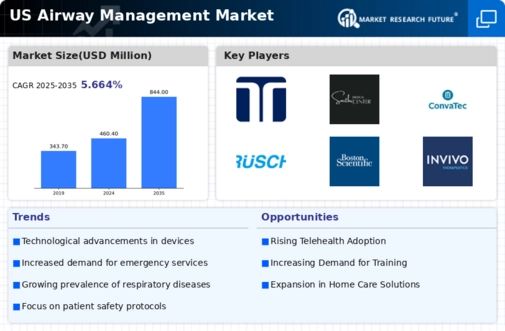Rising Incidence of Respiratory Disorders
The increasing prevalence of respiratory disorders in the US is a critical driver for the airway management market. Conditions such as chronic obstructive pulmonary disease (COPD) and asthma are becoming more common, necessitating effective airway management solutions. According to recent data, approximately 16 million Americans are diagnosed with COPD, which significantly impacts healthcare resources. This growing patient population requires advanced airway management devices and techniques, thereby propelling market growth. Furthermore, the aging population, which is more susceptible to respiratory issues, is expected to contribute to the demand for airway management products. As healthcare providers seek to improve patient outcomes, investments in innovative airway management technologies are likely to rise, further stimulating the market. Thus, the rising incidence of respiratory disorders appears to be a substantial factor influencing the airway management market.
Focus on Patient Safety and Quality of Care
The heightened focus on patient safety and quality of care is driving the airway management market. Healthcare providers are increasingly prioritizing the implementation of best practices and protocols to minimize complications associated with airway management procedures. This trend is reflected in the growing adoption of standardized guidelines and training programs aimed at enhancing the skills of healthcare professionals. According to recent studies, effective airway management can reduce the incidence of adverse events by up to 30%, underscoring the importance of quality care. As hospitals and clinics strive to improve patient outcomes, the demand for reliable and effective airway management devices is likely to increase. Additionally, regulatory bodies are emphasizing the need for continuous quality improvement in healthcare settings, further propelling the market. Therefore, the focus on patient safety and quality of care is expected to have a profound impact on the airway management market.
Technological Innovations in Medical Devices
Technological advancements in medical devices are transforming the airway management market. Innovations such as video laryngoscopes, supraglottic airway devices, and portable ventilators are enhancing the effectiveness and safety of airway management procedures. The integration of artificial intelligence and machine learning into these devices is also improving decision-making processes during critical situations. For instance, the market for video laryngoscopes is projected to grow at a CAGR of around 10% over the next few years, reflecting the increasing adoption of these technologies in clinical settings. Additionally, the development of smart airway management systems that provide real-time data and analytics is likely to enhance patient monitoring and outcomes. As healthcare facilities prioritize the adoption of cutting-edge technologies, the impact of these innovations on the airway management market is expected to be profound.
Growing Demand for Emergency Medical Services
The rising demand for emergency medical services (EMS) is a significant driver of the airway management market. As the population grows and urban areas expand, the need for efficient and effective emergency response systems becomes increasingly critical. In the US, the EMS market is projected to reach approximately $50 billion by 2026, indicating a robust growth trajectory. This surge in demand necessitates advanced airway management solutions to ensure timely and effective interventions in emergency situations. Moreover, the increasing awareness of the importance of rapid airway management in trauma cases is likely to drive the adoption of specialized airway devices among EMS providers. Consequently, the growing demand for emergency medical services is expected to have a substantial impact on the airway management market, fostering innovation and investment in this sector.
Increased Investment in Healthcare Infrastructure
The ongoing investment in healthcare infrastructure in the US is a pivotal driver for the airway management market. As hospitals and healthcare facilities expand and modernize, there is a corresponding need for advanced airway management technologies. Recent government initiatives aimed at improving healthcare access and quality are likely to result in increased funding for medical equipment and training. For instance, the US government has allocated billions of dollars to enhance healthcare facilities, which includes upgrading emergency departments and surgical units. This investment is expected to facilitate the acquisition of state-of-the-art airway management devices, thereby enhancing patient care. Furthermore, as healthcare providers strive to meet regulatory standards and improve patient outcomes, the demand for innovative airway management solutions is likely to rise. Thus, the increased investment in healthcare infrastructure appears to be a significant factor influencing the airway management market.























Leave a Comment